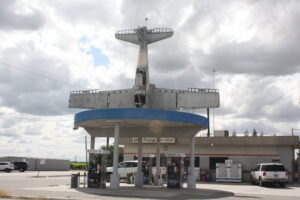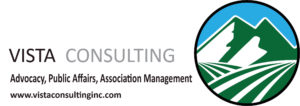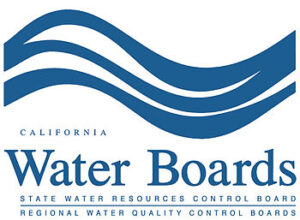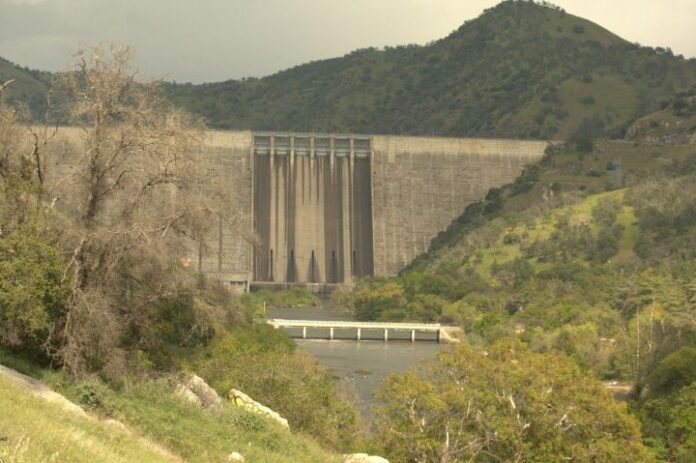 Here we are at day three of the Phase 1A hearing before the State Water Resources Control Board’s office of administrative hearings. You may recall Semitropic Water Storage District in Kern County filed a petition to revoke water right Licenses 11517 and 11521 and a proposed cease and desist order against the Kings River Water Association and its members. Also on board for the ride is Terra Nova Ranch in Fresno County represented by attorney Russell McGlothlin.
Here we are at day three of the Phase 1A hearing before the State Water Resources Control Board’s office of administrative hearings. You may recall Semitropic Water Storage District in Kern County filed a petition to revoke water right Licenses 11517 and 11521 and a proposed cease and desist order against the Kings River Water Association and its members. Also on board for the ride is Terra Nova Ranch in Fresno County represented by attorney Russell McGlothlin.
Here’s the deal as I understand it: Semitropic wants a million acre feet of Kings River flood water diverted to its recharge facilities by way of Angiola Water District. There is a facility near Kettleman City that can be used to move water into the California Aqueduct and on down to Kern County. Semitropic says the Upper River Districts – Alta, Consolidated and Fresno Irrigation Districts have not used the water licensed to them in a beneficial way. For that reason Semitropic wants the State Board to open up the fully appropriated status of the Kings River and allow them the flood water. The folks in the Tulare Lakebed, KRWA and the Upper River say not so.
You may recall a couple of years ago the Office of Administrative Hearings was added to the State Board to lessen its load. At the time there was a lot of talk about that being a conflict of interest as the State Board could act seamlessly as prosecutor, judge and executioner. We’ll see, I like to think as a sound minded American I harbor a healthy mistrust of the government. But at risk of sounding like a butt kisser I’d have to say the hearing officer in this case runs a good meeting and I always appreciate that. If I understand correctly this Phase 1A hearing is for evidence. Once that task is complete there will be a Phase 2A hearing where it will be decided whether this matter should go to the full State Board for a ruling.
The Meeting
Hearing Officer Nicole Kuenzi fired things up at 9:00am, introducing the hired hands Nicole Mullens on exhibit management and Francine Dias as court reporter. Kuenzi started with tying together the lose ends from yesterday’s testimony. There were objections to allowing portions of the testimony into the record. Several actually, but there was some discussion between the attorneys yesterday evening that smoothed out one or two points and Kuenzi sorted out the rest.
One of the sticking points was Semitropic’s attorneys Kevin O’Brien and Sam Bivins objection against the testimony given by what Kings River Conservation District’s General Manager David Merritt said about the Rimes water flow model being incomplete and uncalibrated. There problem here is Dr. Ali Taghavi had testified for Semitropic using data from the model. The attorney for KRWA Leonard Herr and the attorney for the Upper River Districts Nick Jacobs wanted Merritt’s position on the model enter in the record.
So, the day started with the opposing lawyers fighting for what can be done about the Rimes model. The plaintiff Semitropic wants Taghavi’s testimony to be considered good and the defendants KRWA and the Upper River Districts want Taghavi’s testimony considered incomplete and all of that hinges on whether or not the Rimes model is accurate.
There is a legal term; of proof. Bivins gave a statement that the Rimes model was properly completed and calibrated and used by Consolidated and Fresno IDs. Bivins said Taghavi will testify he used the model only in part in developing his testimony. Jacobs said he can offer testimony the model wasn’t completed, calibrated and Dr. Taghavi was one of the developers and was let go from the project because it didn’t work.
Kuenzi said she’d like to hear supplemental testimony on this. Bivins said he’d like to have Taghavi come back on June 17th and Jacobs would like to have someone come in for rebuttal.
Next O’Brien said he spoke with McGlothlin and Semitropic is willing to allow the testimony by the Terra Nova witnesses.
Case in Chief
Jacobs made the opening statement for the Upper River Districts. He said it is a shame testimony limits the mention of SGMA and the impacts on DACs, disadvantaged communities. Yesterday State Board engineer Damon Hess testified he didn’t consider Semitropic’s complaint meets the level needed to proceed in this action. Jacobs said today’s testimony will come from engineer Nick Bonsignore, Wagner & Bonsignore of Sacramento who will testify he had to review and correct Semitropic’s analysis conducted by Polly Boissevain of the firm West Yost. Bonsignore stated he has conducted many of these reviews on matters before the State Board.
Bonsignore said the West Yost estimates were not accurate because two of the KRWA and one of the Pine Flat licenses were not considered in whole or in part. The accounting for losses appeared to be counted twice. He said the actual calculation was re-created to understand what West Yost did. Bonsignore said his analysis of the past 63-years, water was only available in five years. He said the amount of water available was much less than West Yost had figured. He said his analysis didn’t include senior water rights held by the Upper River Districts because the West Yost analysis didn’t include it as part of their calculations and he was trying to back engineer how they got their conclusions.
A technical memorandum from July 2019 from West Yost sent to the State Board showing a revised water analysis was posted and that led to a discussion of whether or not the Upper District licenses were forfeited. Bonsignore also said his analysis of this document showed a lower amount of water available in five-years out of 63-years and it showed a 19-year period where no water would have been available.
Jacobs asked about the North Coast Streams Water Analysis methodology as used by West Yost. That policy requires including senior water rights but the West Yost analysis omitted that from its findings.
Cross Exam
Bivins asked if Bonsignore’s testimony is that the West Yost findings were incomplete, speculative and therefore not relevant. Bonsignore said that is his belief. Bivins asked how Bonsignore came to the conclusion the licenses under question are not in a state of forfeiture. Bonsignore said they are still listed by the State Board as in effect. It got a little twisted about here as Jacobs repeatedly objected to Bivins’ questions and Kuenzi asked Bivins to reword. This happened a lot and became a bit difficult to follow.
Kathleen Miller, California Department of Fish & Game – excuse me – Wildlife, asked Bonsignore if he agreed with the North Coast methodology and he said no. With that Bonsignore was dismissed as there was no redirect. This ended the Upper River’s Case in Chief portion. Herr said he has a court date he has to keep and Joe Huges will take his place. The hearing went to recess for 10-minutes.
Part II of Part III I Think
Kuenzi reconvened at 10:25am saying it is time to go over the exhibits and testimony being included or excluded from evidence. They came to some agreement.
The Tulare Lake Bed Water Storage District’s attorney Peter Kiel gave the case in chief opening statement saying Semitropic’s complaint didn’t include the other stream flows into Tulare Lakebed and attacked the witnesses, specifically engineer Kevin Johansen instead of the validity of his testimony.
Mark Unruh was the first witness for TLBWSD. He has an agricultural engineering degree from Cal Poly and now works for the JG Boswell Company. Previously he worked at Fresno ID where he worked on canal projects. On a typical year more than 100,000 acres in TLB is irrigated. Most of the crops are annual giving flexibility to planting acreage.
Unruh said there are more rivers than the Kings River flowing to the lakebed. His list included the Kaweah, Tule and White Rivers and Deer Creek. He said the lakebed is like a dish more than a bowl as it is shallow. There is a Reclamation District that protects the City of Corcoran and the state prison from flooding. A map was posted showing the eight or nine different cells of the lakebed that showed how flood waters are dealt with. At the southern portion of the lakebed is an area dedicated to water storage. During a flood event water is pumped to the dedicated storage to preserve farmland. Once that space is used a decision is made as to which farmland cells will be flooded.
The next exhibit posted on screen was the Army Corps of Engineers Reservoir Regulation Manual. Unruh said Pine Flat on the Kings is an ACE dam. The purpose of Pine Flat Dam was listed as keeping floodwater out of Tulare Lakebed. The Terminus Dam on the Kaweah River and the ACE manual lists it. Schafer Dam on the Tule River, recently renamed in honor of engineer Richard Schafer, a finer gentleman you will not encounter in this life, is also mentioned. Unruh said Boswell is the operations control for the lakebed. It is very important to monitor upstream flows at all times. The land is pre-irrigated in October through November. Planting begins in February or March. Late May or early June is the first cotton irrigation. In the past 15-years he has only had to deal with flood flows four times.
Cross Exam
O’Brien asked to refer to JG Boswell as Boswell and the TLBWSD as TLB. Unruh was fine with that. O’Brien asked how many acres Boswell owns and Unruh said 120,000 or so with about 100,000 irrigated if supplies are available.
Unruh’s declaration was posted and there was a statement that said TLB manages water diversions at Empire #2 Weir but Boswell manages water within its land. O’Brien asked if his testimony was farmland flooding is always a significant concern and Unruh said yes. O’Brien asked if in Unruh’s opinion does the TLB board and Boswell share that concern. The answer was yes because Boswell is a farming business that can’t farm flooded land. The testimony showed the dedicated storage can hold 150,000 a/f. The dedicated storage area is also called the South Wilber area and has further divisions named after Haciendas. They are shallow and O’Brien asked if they would evaporate faster. Unruh said it’s surface area not depth that determines evaporation. O’Brien asked if Boswell tracks the amount of evaporation as a separate calculation. Unruh said elevation records are kept but the evaporation loss isn’t recorded. These records are kept by Boswell. Unruh said it depends on temperature and surface area on how much is lost to evaporation. During the hottest times of the year a half foot to a foot per acre a month in elevation can be lost was Unruh’s estimate. Unruh said Boswell hasn’t been looking at increasing storage capacity.
O’Brien asked if 2006, 2011, 2017 and 2019 were the most recent years flood releases threatened farming and the answer was yes. Unruh said when the Tule and Kaweah River releases exceeded irrigation demands there had to be pumping to storage. He said Deer and Poso Creeks don’t have dams so water gets there when nature says so. O’Brien asked what happens in those wet years when storage capacity is maxed out. Unruh said the four years listed were manageable before farm cells had to be flooded.
The last time farm cells were flooded was in 1997 and 1998. Unruh said he knows about those years from inspecting inhouse records and consulting with long-time Boswell employees. O’Brien asked what happened to the excess water in those years and Unruh said a levee was cut and the water flooded a farm cell. As the flows receded the cell was dewatered by pumping it into the South Wilber as space became available. In 1983 water was pumped out of the lakebed into the South Fork and ended up in Mendota Pool if I understood correctly. Unruh said the conveyance of the South Wilber back to the farmland is gravity fed and 1,400 a/f per day or 700 cfs can be released. O’Brien asked if groundwater is stored at South Wilber. Unruh said yes groundwater is pumped and conveyed to dedicated storage. There are 61 working wells that can put out 260cfs. He said cotton irrigation is the big determining factor on how the water is managed. He doesn’t see any surface water making it to dedicated storage this year. In 2017 the dedicated storage was all surface water and Boswell cut back on its groundwater pumping. Boswell has supplies from the State Water Project and the Kings, Tule and Kaweah Rivers. Unruh said he provided water information and data to a consultant for the TLB named Meyer. O’Brien asked if Meyer took the lead role in preparing the license analysis and Unruh said Meyer was involved but Johansen took the lead role. He also said the amount of water used for irrigation wasn’t separated from the other figures given Meyer.
groundwater is stored at South Wilber. Unruh said yes groundwater is pumped and conveyed to dedicated storage. There are 61 working wells that can put out 260cfs. He said cotton irrigation is the big determining factor on how the water is managed. He doesn’t see any surface water making it to dedicated storage this year. In 2017 the dedicated storage was all surface water and Boswell cut back on its groundwater pumping. Boswell has supplies from the State Water Project and the Kings, Tule and Kaweah Rivers. Unruh said he provided water information and data to a consultant for the TLB named Meyer. O’Brien asked if Meyer took the lead role in preparing the license analysis and Unruh said Meyer was involved but Johansen took the lead role. He also said the amount of water used for irrigation wasn’t separated from the other figures given Meyer.
O’Brien asked if Boswell’s pumping quantities have increased and Unruh wasn’t certain. O’Brien had him read from his declaration. The part he read was about how the State Water Project hasn’t been able to meet its contracts and landowners in TLB will become more reliant on groundwater or other sources.
O’Brien asked about yesterday’s testimony on Kings River water going into the Friant Kern Canal during flood years. Unruh said there is a pump station maintained by Reclamation District #770 Delta Lands located near where the Friant Kern Canal siphons under the Kings River. Some Kings River water was pumped into the FKC in 2017. O’Brien asked if Boswell has been part of any transfers of Kings River water outside of Kings County. Unruh wasn’t able to answer that question. O’Brien asked a lot of questions Unruh didn’t have the answers to and followed up with where Unruh thought he might find the answer. That ended O’Brien’s line of questioning.
Kuenzi asked Unruh about pre-irrigation. Unruh said the soil in the lakebed is heavy clay and when water is first introduced it can get slick. Pre-irrigating the land prepares it to be worked so seed can be planted with a full soil water profile. He said they start with the heaviest soils so they can get dry enough to get planted. Kuenzi asked if there is a salt concern in the lakebed. Unruh said there is a Tulare Lake Drainage District that is responsible for taking tile water and getting the salts out of the area. Kuenzi asked if TLB’s goal is to avoid flooding the farm cells and Unruh said that’s more of a goal of the landowners. She also wanted to know if the cells flooded were owned by Boswell and yes they were. It was also affirmed TLB doesn’t own or manage any groundwater.
Kuenzi asked the State Board’s Kyle Wooldridge if he had questions and Wooldridge asked how Boswell gets water from KRWA. Unruh said Boswell keeps estimates on how much water it will need and what’s available. It puts orders in advance to try to have deliveries arrive at the best time. Boswell has canals and the land is flat so flow is fairly slow so this all has to be planned out. This same canal system can be used to move water to the dedicated storage but pumps are needed. Wooldridge wanted to know how Boswell determines how much dedicated storage it will need. Unruh said planning for a normal year and flood flows are different. Wooldridge wanted to know if Boswell requests water from KRWA to put into storage. Unruh said the water going to dedicated storage is mostly flood or groundwater. He told Wooldridge Boswell keeps an eye on the snow pack and used that info for estimating how much to plant. Wooldridge asked if SWP supplies could go to dedicated storage and the short answer is yes that can happen. Unruh added SWP supplies are most often used during the summer for peack need supplements.
Kuenzi asked Kiel if he had any redirect questions and that will take place after lunch. Kuenzi asked everyone to log out at 12:28pm and then back in before 1:30pm.
Part III of Part III
The show started again at 1:31pm. Kiel had no redirect for Unruh and he called Jeffrey Meyer. Meyer said he’s a registered engineer and he’s a Cal Poly guy with 30-years experience with many different facets of water engineering including modeling. He was hired by TLB to provide a review of Semitropic’s filing. Bivins objected as Meyer meandered and Kuenzi asked him to stick to the subject without too much detail. Again Bivins objected as Meyer spoke about things not in his written testimony. Kiel directed Meyers to please stay on the direct topic.
Meyer said he looked over the licenses and after a tour of the Tulare Lakebed he worked up some figures and believes the demand estimates were off. He contacted KRWA and Johansen and again Bivins objected. Kuenzi asked him to again please stick to the written testimony and asked Kiel to help his witness to stay on topic. One could see Meyer was growing frustrated but he did limit his comments.
Meyer said he looked over the licenses and rights they entailed. He said he discovered the license reports were missing data which needed to be updated. Once the revisions were made there was determined a greater use of the water rights than indicated. I believe this is one of the defendants’ main points but also one of the main points of the plaintiffs addressing if the water is being used according to the license.
An exhibit was posted, a table of figures with hand written notes on water conditions from 1968 and 1969 used by Boissevain in her testimony earlier. Meyer went over the calculations. I must admit I was lost as to how the calculations were made in the first place let alone errors. But the table posted dealt with the licenses and permits water usage.
Meyer said the license states it won’t limit flood flow diversions. Bivins objected but it looks like Kiel found it in the written testimony. Meyer said since the Tulare Lakebed is the terminus for multiple streams he believes the State Board recognized there are conditions where storage could exceed the license.
Next a chart was posted showing a schematic of how the lakebed gets water. I couldn’t read it the type was so small. Meyers said his finding is the Kings River is the only conveyance that has flood control features. Water can be sent down the North Fork and help protect the lakebed from flooding. Any other stream’s flood releases are coming to the lakebed. He put up scenarios from 2015, very dry and 2017 wet. Meyer said this is the operation type used in developing models for guiding flood control operations. He also said this chart is where O’Brien can find the data Unruh gave him.
Meyer said the license is based on 1969 the wettest year on record for Tulare Lake inflow. In 1997 the Kings, Kaweah and Tule Rivers were all making early flood releases causing a great deal of storage on the lakebed. He gave all the figures verbally so I didn’t try to write them all down. Meyer said he thought the beneficial use was under reported in the Semitropic complaint and the holistic view of the Lakebed wasn’t used but should have been.
Cross Exam
Bivins had Meyer’s declaration pulled up and Meyer was asked to read from it saying all the water reaching the lakebed in 1969 was put to beneficial use. Bivins asked what beneficial use was, and how is it used. Meyer said it was used for irrigation as the beneficial use. Bivins was trying to get Meyer to say all the water was used for irrigation I think. Kuenzi asked Meyer how he determined all the water was put to beneficial use. Meyer said change in storage and direct diversion was the methodology he used. Bivins asked if all the water in the lakebed in 1969 was applied to irrigation. Meyer said eventually. He said it could be stored and used in a later year. Bivins asked hypothetically if he owned a parcel of land near a river and a levee breaks and his land was flooded. He asked if he let the water sit there until it recharged or evaporated would that be a beneficial use. Meyer said hypothetically the water came from a natural channel it would be a beneficial use. Bivins then asked if he let water sit and then pumped it back into the river would that be a beneficial use. Kiel objected but Kuenzi overruled. Bivins asked if storage alone would be a beneficial use. Meyer said no and wanted to know the purpose of the reservoir but just storage for the sake of storage wouldn’t be beneficial.
Bivins asked if Meyer tried to quantify how much water in 1969 was used for irrigation and how much was pumped out of the lakebed. Meyer said he got his information from the State Board and wasn’t aware any water was pumped out. He was asked if he could determine if the evaporation could be determined from 1969. He said evaporation could be determined if the data was provided. Bivins asked if Meyer thought the evaporation was beneficial use and Meyer said that was part of the operational loss of any storage.
Next Bivins asked if Meyer knows Jim Provost and his reputation. Meyer doesn’t know Provost. A letter from Provost to the State Board stated, “Tulare Lake receives water on an unwilling basis. . .” Bivins asked Meyer if he knows TLB manages water for its clients and Meyer said he didn’t know the arrangement. He was asked about the general purpose of an ag water management plan and wanted to know if that should be consulted if someone wanted to know how the water was being used. Meyer said yes.
There was a bit of a delay here while a document was being posted. Sometimes you get an idea of where an attorney is trying to lead a witness but I got no read on Bivins. You kind of expect a gottcha or a Perry Mason witness breakdown but that doesn’t really happen much in real life.
The Tulare Lake Basin Ag Management Plan 2015 was posted. It was 200 pages long and TLB attorney Aubrey Mauritson objected in advance that Meyer has not read this document. Kuenzi took that on advisement but allowed Bivins his questions. There was a chart that included amounts of flood water and river runoff. Bivins asked about them but Meyer hadn’t had a chance to look it over. Bivins asked if SWP water would be beneficial use and Meyer said no as that isn’t a part of the license. Mauritson objected once again that there hasn’t been a review of the document and Kuenzi sustained.
Bivins asked if Meyer was part of the decision to revise the reports and he was. Bivins asked if anyone mentioned to him this wouldn’t look good. Mauritson objected and it was sustained. Bivins asked if it made him uncomfortable that refiling the reports could reflect on Jim Provost’s veracity. Meyer said no. Meyer’s written declaration was that in 2006 there was 40,000 a/f stored in the lakebed. His declaration also used the term damaging inflows meaning flood water that would hurt crop production. He agreed there has been intensive farming on the lakebed for some time. Bivins asked if TLB would prefer to avoid flooding on the land and Meyer said he figures farmers would want to farm. Bivins asked if that was based on economic losses. Meyer said that would be a major consideration. That ended Bivins questions.
Wooldridge had a question about a spreadsheet number from 2017, where did the numbers come from? Meyer said from Johansen’s spreadsheet. That was the last of the questions and ended the case in chief testimony. Kiel wanted to include the applicable exhibits into the evidence. Kuenzi asked if Semitropic had objections and Bivins said they are reserving objections until after the rebuttal. With that we took a break at 3:00pm on the nose.
Terra Bossa Nova Ranch
Before anything else happened Kiel and Mauritson objected to admitting the Ag Water Management Plan of 2015 as evidence on the grounds that only Bivins questions came close to testimony since he was the only one to mention it. Kuenzi allowed its inclusion. She then polled the attorneys about how long they think rebuttal witnesses would take. It would be a few more hours so the rebuttal witness testimony will come at another meeting on June 17th or 18th.
McGlothlin made his opening statement saying Terra Nova is a 9,000 acre ranch using diverted flood water from the James By Pass that makes an innovative use of these waters. It can now divert 500 cfs for recharge and is routinely held up as a model for on farm recharge. Don Cameron and Dr. Phil Bachand will testify. Kuenzi swore them both in. Cameron is one of the owners and manager of Terra Nova Ranch. If you know who he is then you know his pedigree and experience is long. In fact McGlothlin introduced Cameron as the God Father of Recharge. Bachand runs a consulting and research firm dealing with ag water.
Exhibit Terra Nova #3 was posted and it showed a picture of a flooded vineyard. Cameron said Terra Nova is just east of the North Fork Kings River at the James Bypass. He’s at the end of the system and only receives water in wet years in part to channel losses. He said all his permanent crops are on drip, either above ground or subsurface. He said the vineyard in the photo stayed flooded from March to May and produced just fine.
Bachand put up a slide of flood flows on the James Bypass and said while they can be devastatingly damaging they can also provide a water source. Cameron said Terra Nova has been working on capturing flood flows and recharges as much as it can. It sits over a cone of depression and I know it’s a part of the McMullin GSA which doesn’t have surface supplies.
There was other photos showing how the on farm flood works. It’s sandy soil so the water goes in pretty fast. They’ve made some great strides to recharging the groundwater. Bachand said flood water from 2011 forward has been used for on farm recharge. Since 1982 Terra Nova has been able to take 33,600 a/f of flood flows. Much of this was measured simply by today’s standards. He said the McMullin Project is on Phase II which will expand the diversion of flood flows to 20,000 a/f. He said the project saves money and it is a direct benefit to the aquifer. He said it is flexible as different crops can still grow during the recharge. Bachand pulled up a chart of James Bypass flows since 1948 and showed how much could have been captured at full buildout. There’s been almost 10 million a/f flow by since then. Capturing that water also benefits everyone in the area.
Cameron showed an aerial photo with the McMullin project overlaid. There are canals and pumps in place and more to come. The turnout and canal are big. It was built in time to get some 2019 flows. Suddenly there was a host of objections from both Semitropic and the Upper Rivers. Interesting. Semitropic objected to relevance and Jacobs objected because the SGMA portion of his clients efforts were not allowed. Herr from KRWA also objected on the same grounds as Jacobs. At some earlier hearing Kuenzi had excluded testimony that included SGMA or DACs. Kuenzi allowed a wrap up which was really McGlothlin saying that was all they had to say.
Cross Exam
O’Brien asked Cameron if Terra Nova’s 9,000 acres is in the place of use of the disputed licenses. Cameron wasn’t sure. O’Brien asked if he had had a discussion with KRWA. Cameron said the first flood water taken was in 2008 and the term was five years until 2020 when it was shorted to one year terms. Objections. O’Brien asked if by speaking with KRWA he discussed water rights. Herr objected as Cameron’s opinions on water rights isn’t relevant. Kuenzi allowed the question. Cameron said his understanding is they receive water under a pre-1914 agreement but then he said he wasn’t sure. Herr disagreed saying the question is has Cameron developed an opinion on what water rights underpin the water he received. Herr said this isn’t tied to anything his client KRWA may or may not have said. O’Brien rephrased asking if Cameron has a knowledge of water rights on this water and that was objected to and sustained. O’Brien tried again asking if Cameron has a right to the water and Cameron said his understanding is KRWA would not object to them taking flood water. The agreement was modified in 2017 by KRWA allowing KRCD to take the water until 2020. A new agreement is pending.
Herr did not have a follow up question but moved to strike the testimony. O’Brien said Semitropic did object originally and then agreed to hear this but KRWA and the Upper River didn’t, now the horse is out of the barn. McGlothlin said he doesn’t want to have this stricken from the record and then have it come back. Kuenzi allowed the Terra Nova testimony.
Herr asked Cameron if anyone at KRWA has discussed water rights on this project for this proceeding. Cameron took his time to be sure and said no. He also said he’s not entering an opinion on the water rights. Jacobs asked if Cameron knows if pumping at his ranch has caused the reduction of groundwater levels. McGlothlin objected as Cameron isn’t a hydrogeologist. Jacobs said Cameron was presented as the godfather of recharge. McGlothlin said that’s different from being a hydrogeologist. Kuenzi had Jacobs rephrase the question. Cameron said he didn’t have direct knowledge of just how much Terra Nova pumping may have contributed but it does have an effect. That ended the Terra Nova case in chief. Herr and Jacobs objected to allowing the Terra Nova portion to be placed in evidence. Kuenzi said she hopes the attorneys will get their positions state earlier and save time. She will allow Terra Nova into the evidence.
The Next Step
The next step is having the rebuttal take place on June 17th. Kuenzi asked Herr if KRWA could present its rebuttal evidence on the 17th before Semitropic on the 18th to accommodate TLB’s schedule. Herr was hesitant saying he would not like that as some problem with the testimony could arise he would want to address. Jacobs said the Upper Districts are flexible. Kuenzi asked if Dr. Taghavi could testify about the model on the 17th and Jacobs and Herr would try to make that happen. Kiel wasn’t available on the 17th at a 9:00am start so the hearing will start at 1:00pm. Semitropic’s rebuttal will start June 18th. O’Brien asked Jacobs to announce the name of his witness before the hearing starts. There is a June 10th deadline for naming witnesses and submitting written material.
Kuenzi asked if there was anything else. Jacobs asked about receiving a transcript. Bivins said Semitropic and KRWA are splitting the costs on the court reporter. Ms. Dias said she’ll send out an email to everyone on the service list if Bivins and Herr are OK with this. They will give Kuenzi a free copy. Good deal. That was about it and Kuenzi thanked everyone, wished them a good weekend and will see them on the 17th. That happened at 4:14pm.
DISCLAIMER OF RESPONSIBILITY; Waterwrights strives to provide its clients with the most complete, up-to-date, and accurate information available. Nevertheless, Waterwrights does not serve as a guarantor of the accuracy or completeness of the information provided, and specifically disclaims any and all responsibility for information that is not accurate, up-to-date, or complete. Waterwrights’ clients therefore rely on the accuracy, completeness and timeliness of information from Waterwrights entirely at their own risk. The opinions expressed in this report are those of the author and do not represent any advertisers or third parties.
most complete, up-to-date, and accurate information available. Nevertheless, Waterwrights does not serve as a guarantor of the accuracy or completeness of the information provided, and specifically disclaims any and all responsibility for information that is not accurate, up-to-date, or complete. Waterwrights’ clients therefore rely on the accuracy, completeness and timeliness of information from Waterwrights entirely at their own risk. The opinions expressed in this report are those of the author and do not represent any advertisers or third parties.
ALL RIGHTS RESERVED. Copyright 2021 by WaterWrights.net/DAW






























